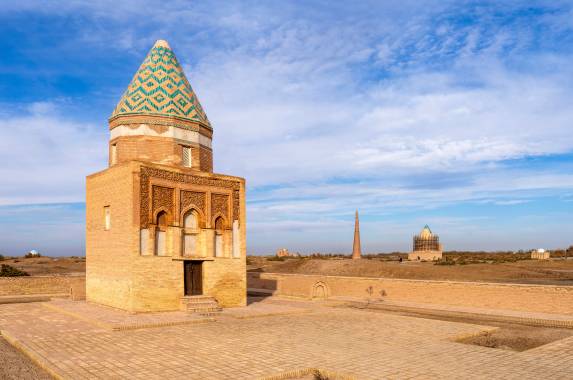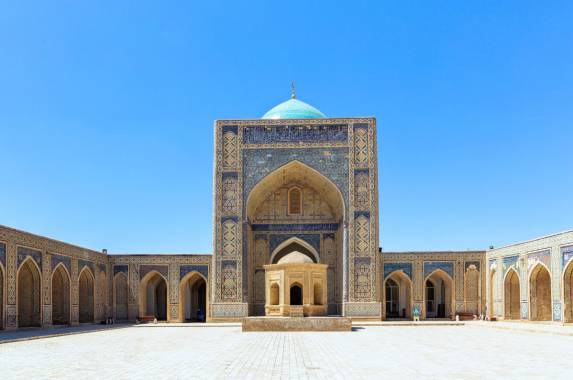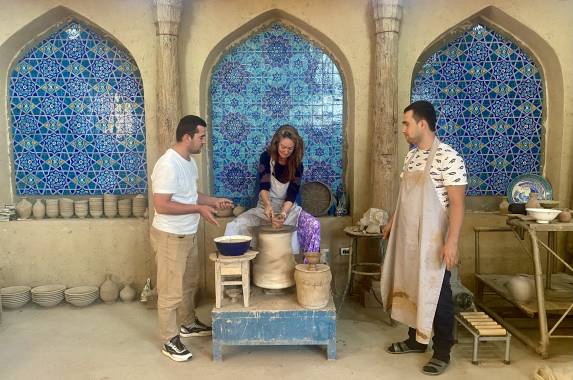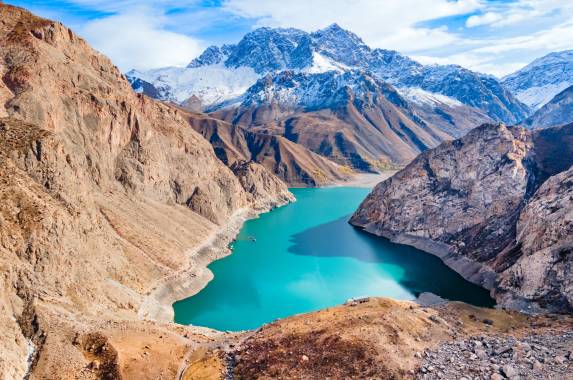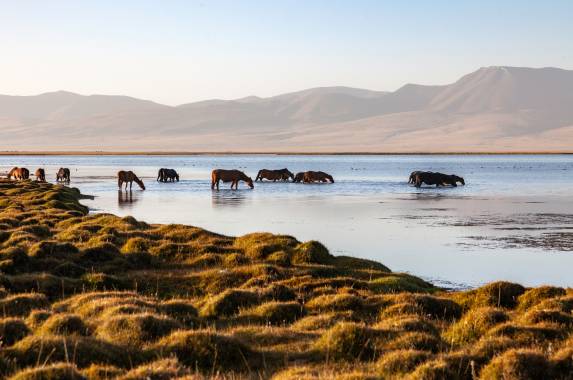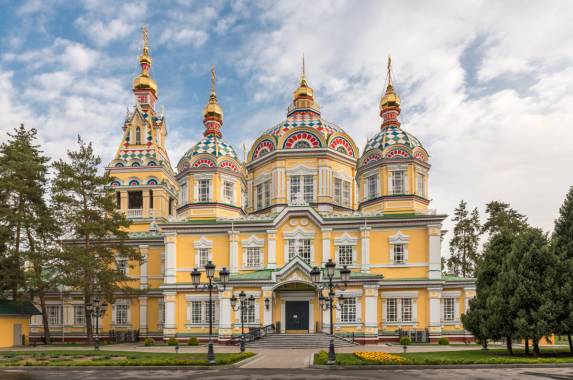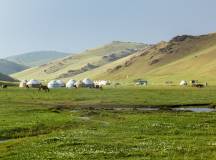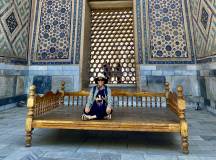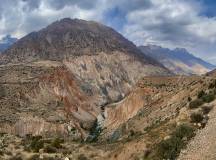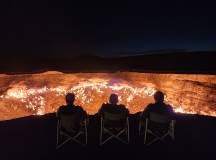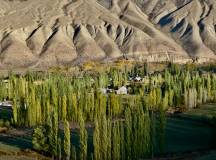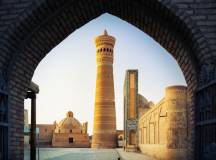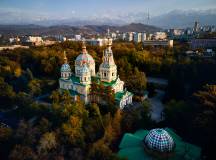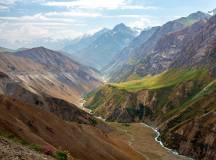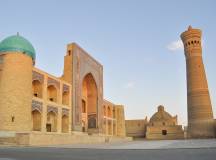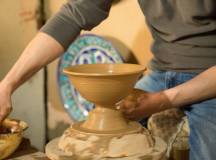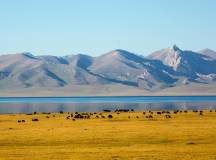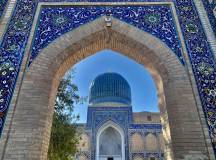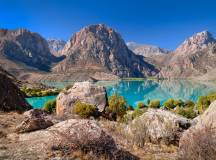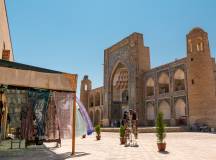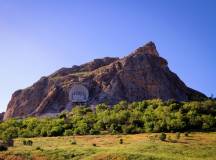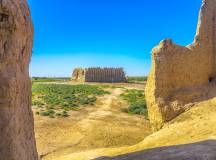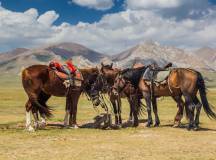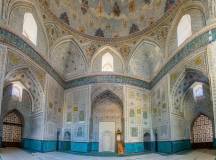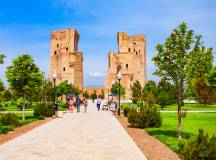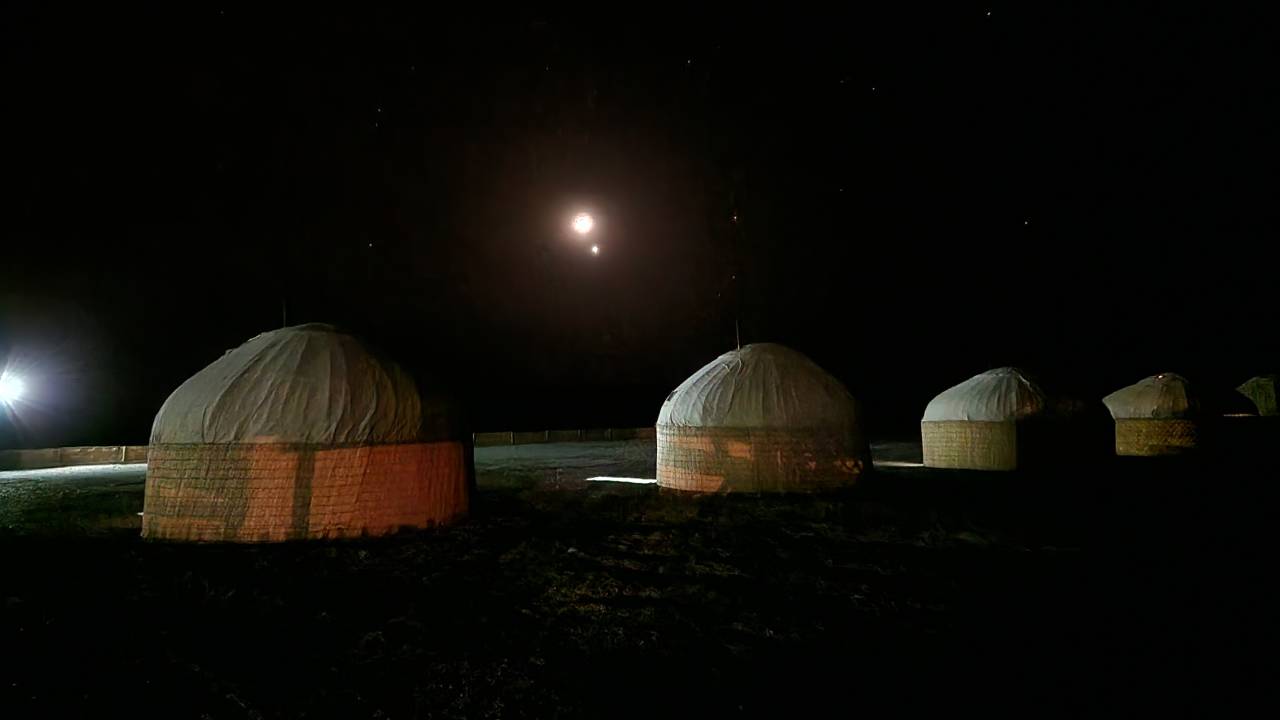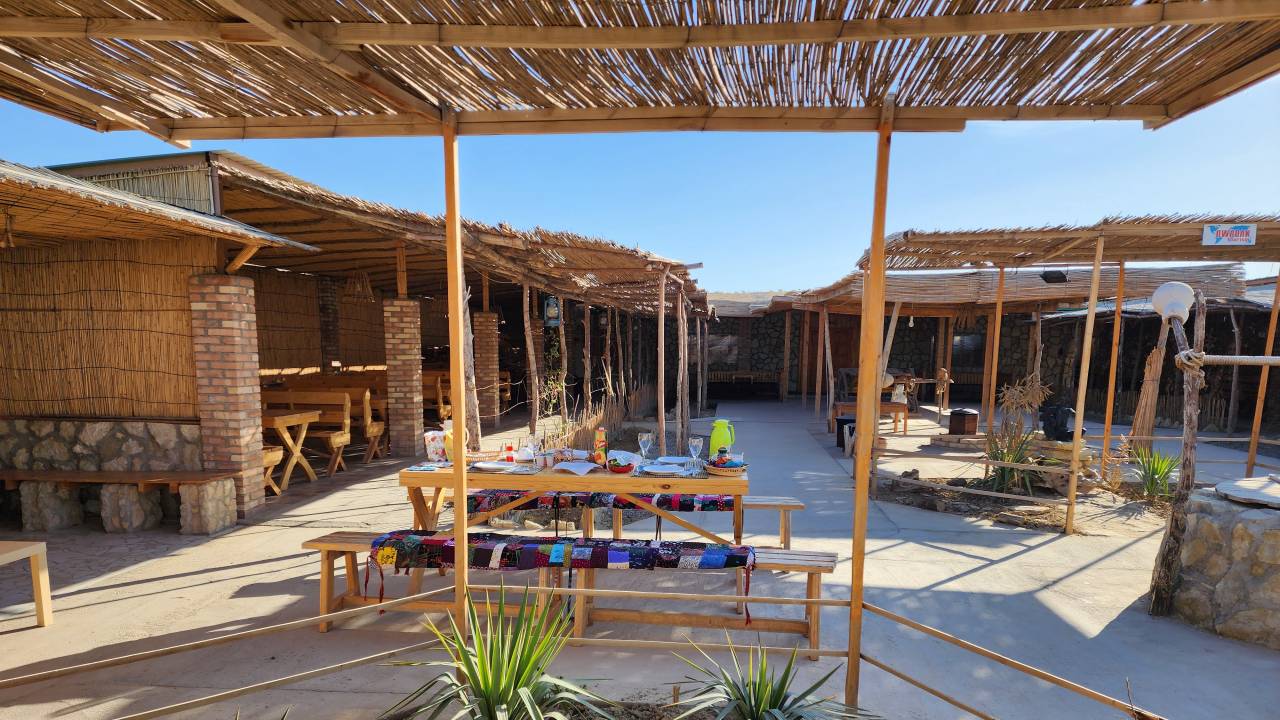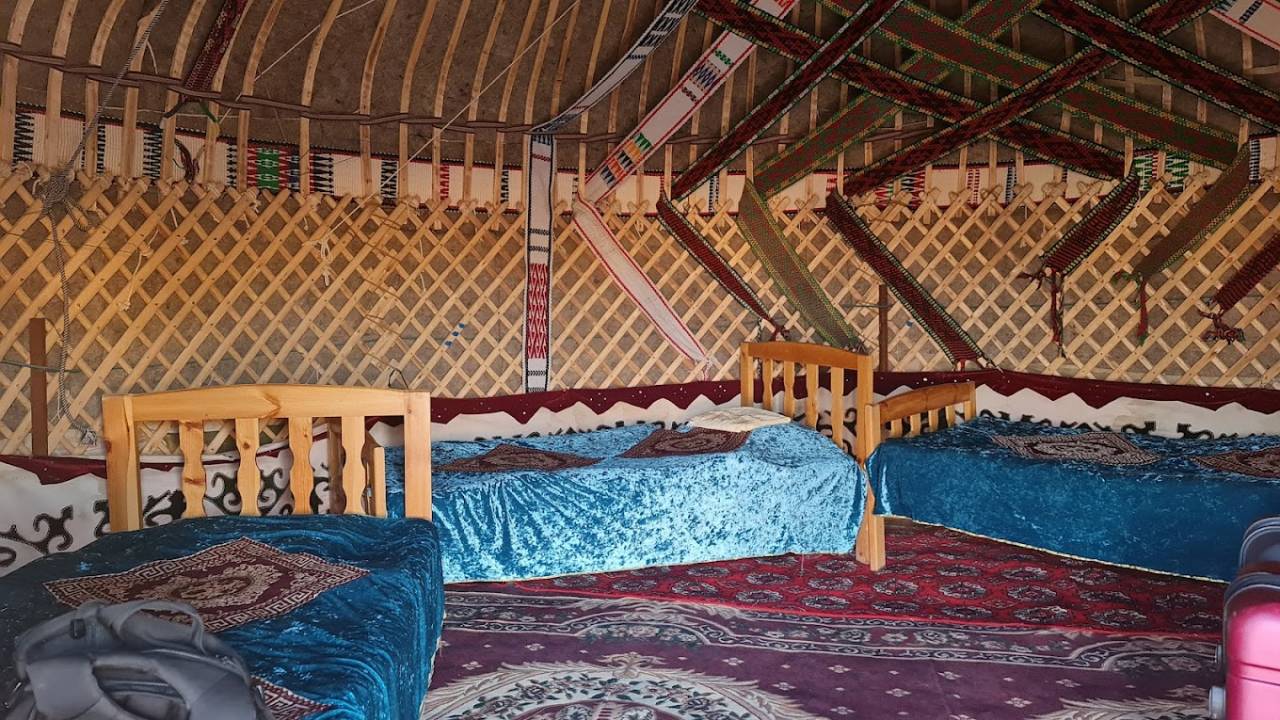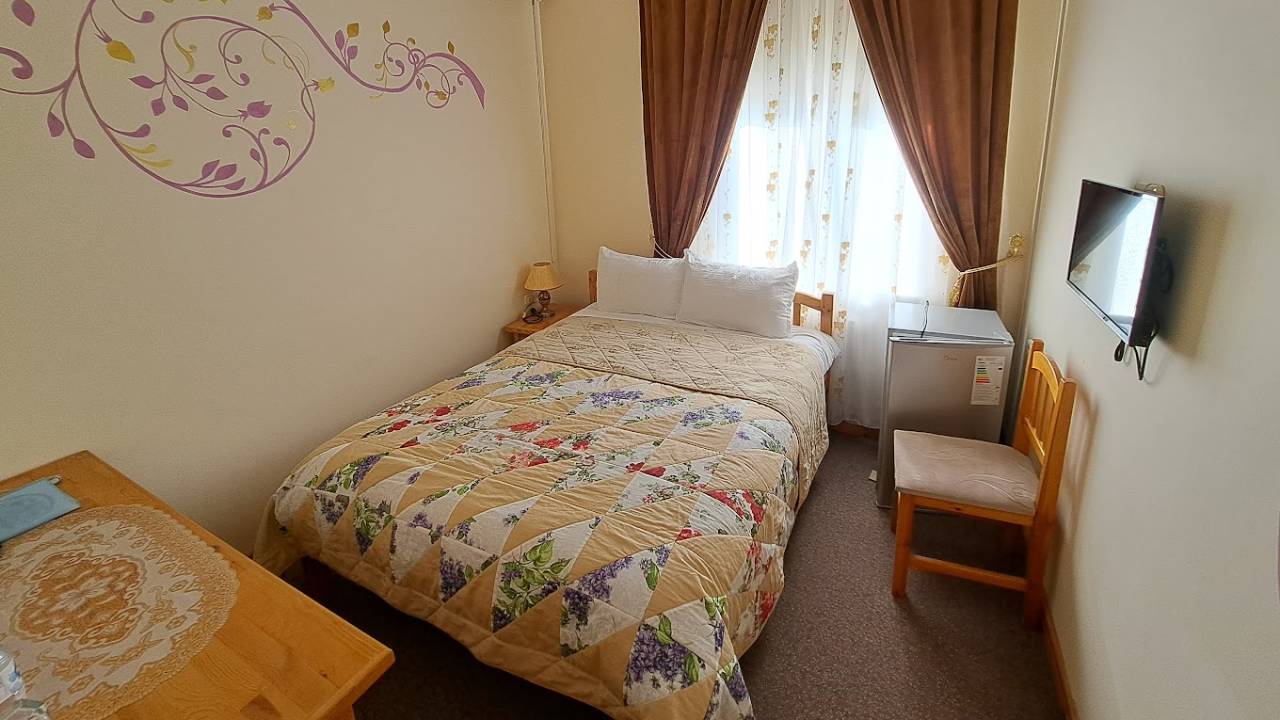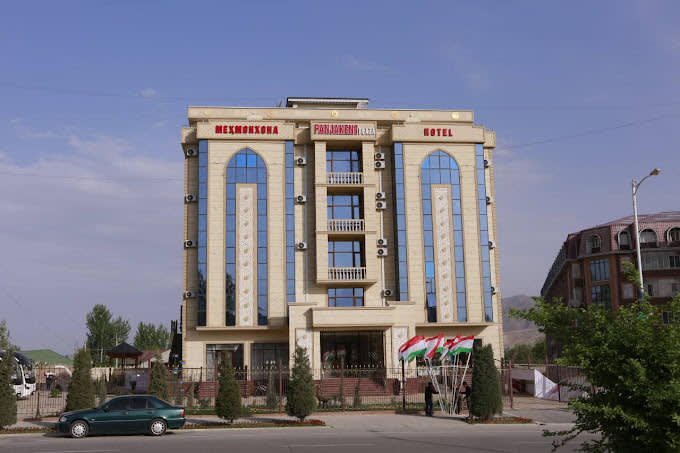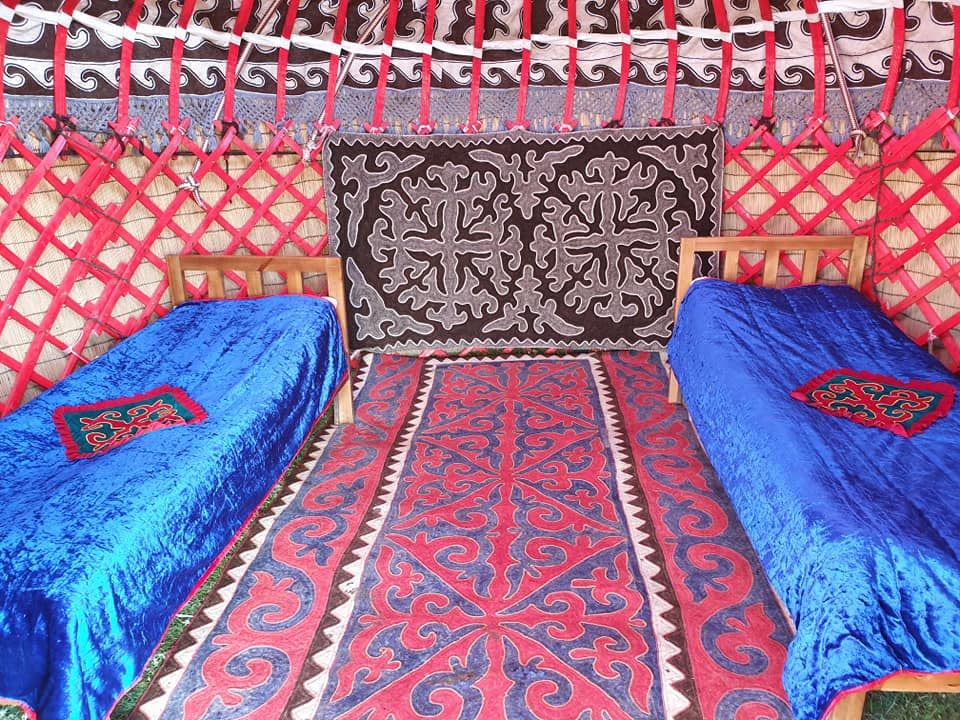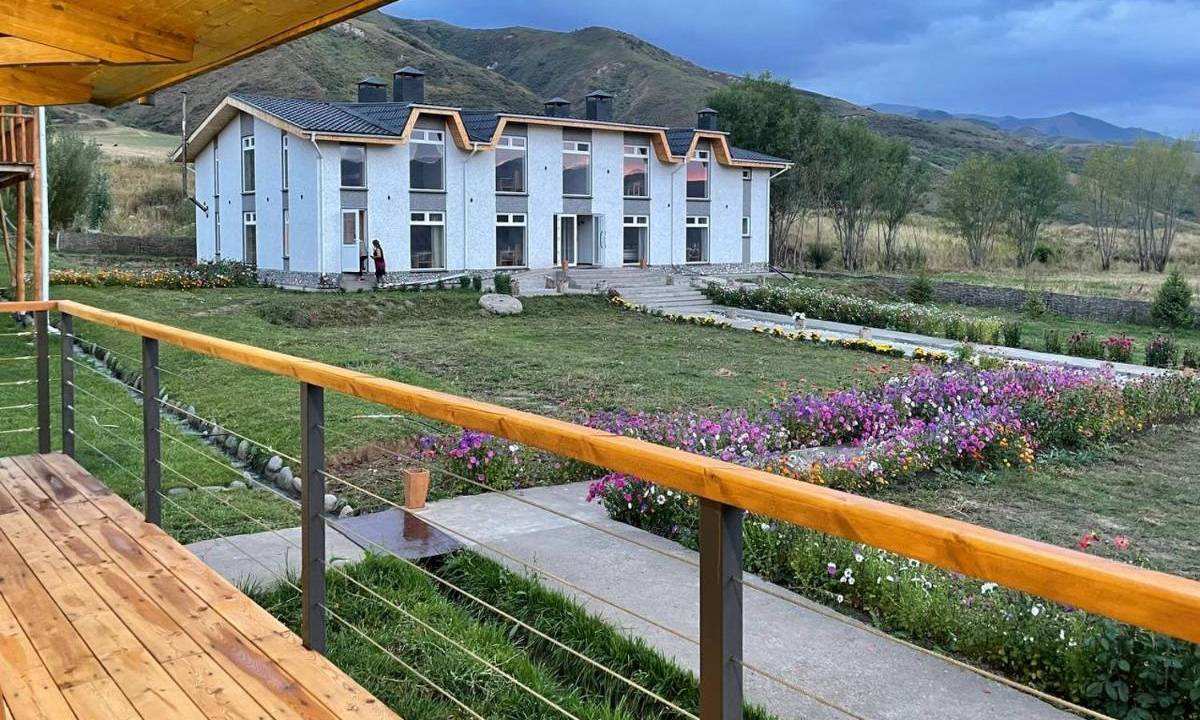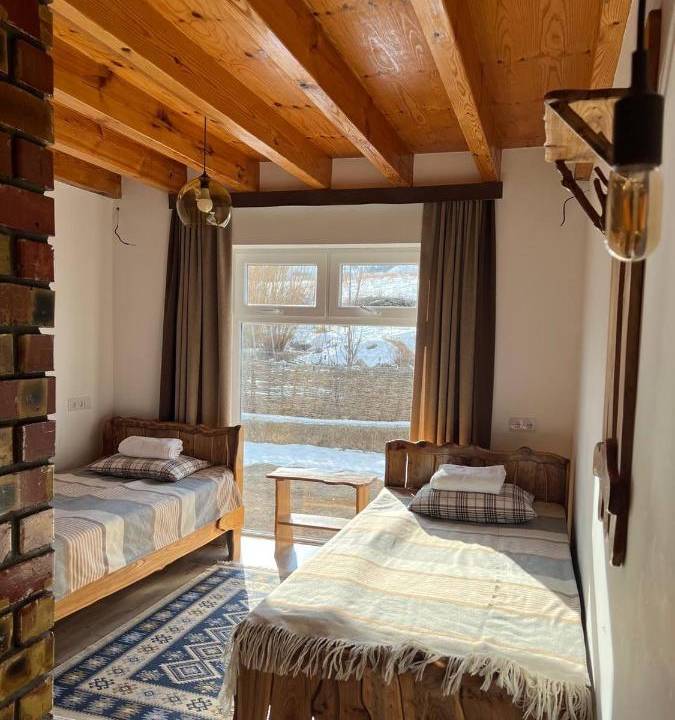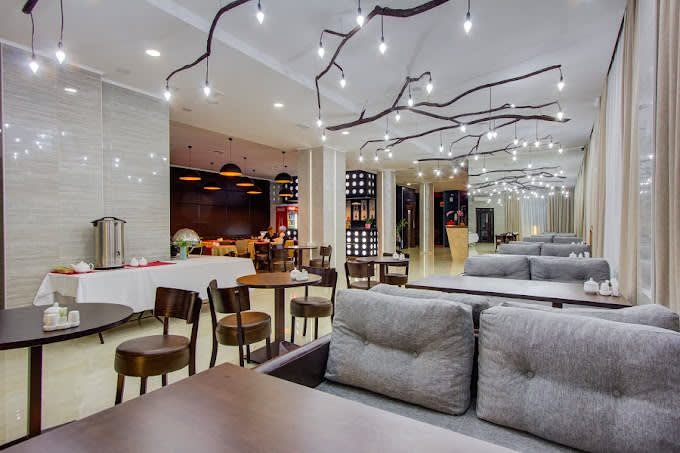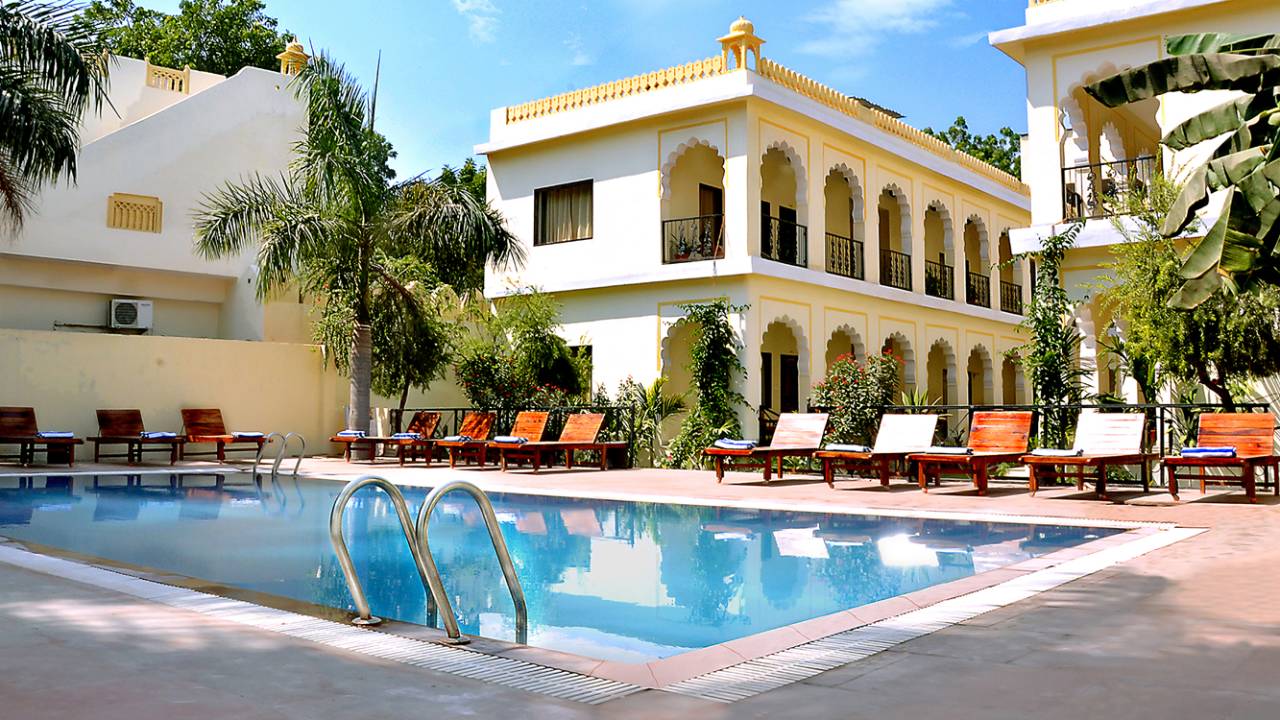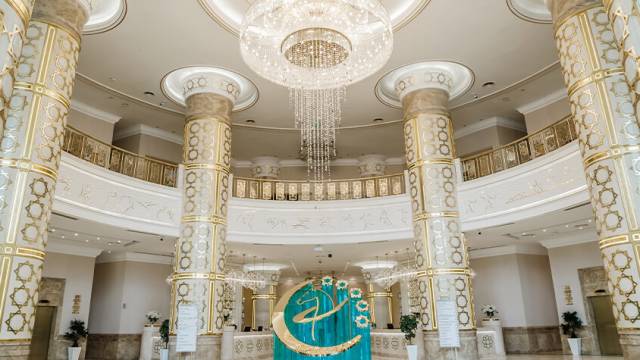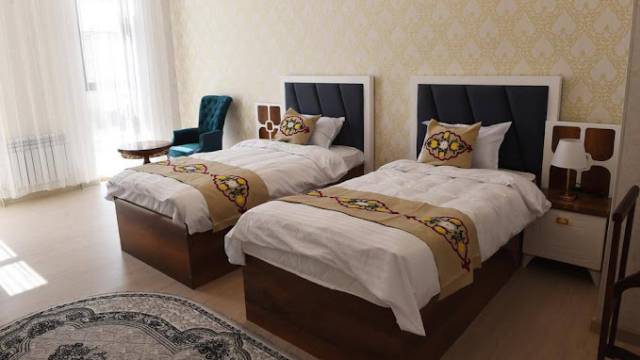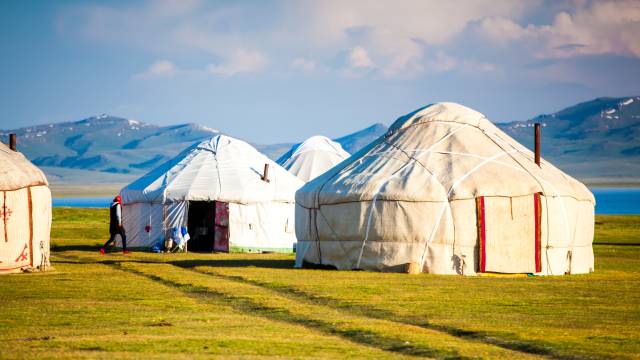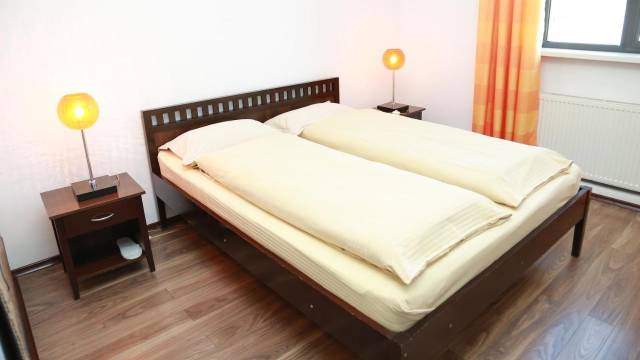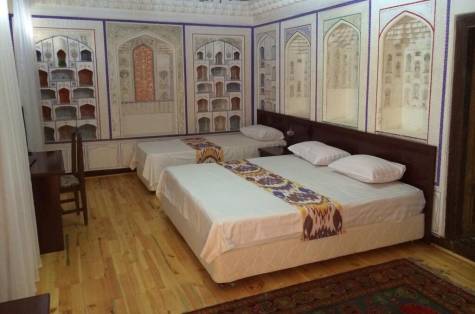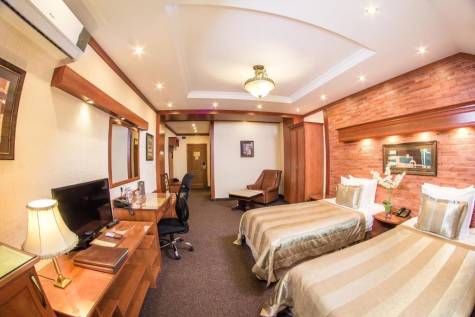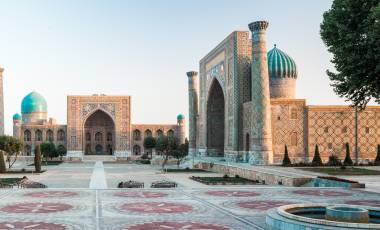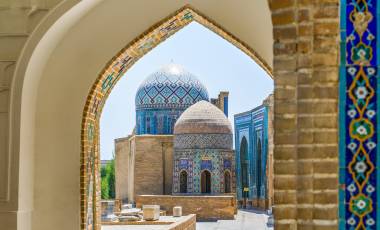- Follow the footsteps of ancient traders on a journey along the Silk Road
- Witness the ‘Door to Hell’ at night, a giant burning gas pit in Turkmenistan
- Experience the life of a nomadic shepherd with two nights in a yurt camp
- Discover the great Islamic architecture and ruins of five different countries
- Explore the villages and lakes of the Fann and Tien Shan mountains
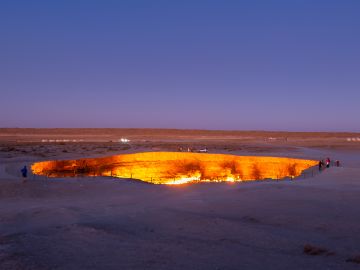
The Five Stans of the Silk Road
- Home
- Asia
- Uzbekistan
- Culture
- The Five Stans of the Silk Road
Reviews
Add your own reviewAmazing!
If you want to discover 5 countries and their varied cultures, histories and scenery and meet some lovely people, all in three weeks, this trip is for you. We saw some wonderful, stunning scenery, met some amazing friendly people, found out about the past complicated history and the challenges they face today. It is fast paced, there are long journeys but totally worth it and loads to see and do on the way.
Most Inspirational Moment
The stay at Lake Son Kul..Riding horseback along the shores of Lake Son Kul, watching the sunset, visiting the family nearby in their yurt who spend their summer in the hills, sleeping in a yurt overlooking the lake for 2 nights and climbing the hills behind for great views of snow capped mountains!
Thoughts on Group Leader
Ale Moreiras (Alex) was amazing and up their with the best of the leaders we have ever had. He was caring, attentive to individual needs, super organised, energetic, knowledgeable, efficient and funny.
Advice for Potential Travellers
Get your visas sorted well in advance! Especially Tajikistan as it will probably be rejected the first time or you will be asked for further information before it is processed. Don't stress about the entry date; put down the date a couple of days before you expect to enter to be on the safe side as it is valid for 30 days. Take lots of layers as temperatures varied from zero to 40 degrees. (June) You will probably only need one set of cold weather clothing,(fleece, coat, hat) for Lake Son Kul but worth taking. Trousers that zip off to shorts are particularly useful for temperatures that fluctuate during the day. Men need knee length shorts or trousers for Mosques but usually they provide a skirt to wear ontop of shorts. Ladies need to cover knees and shoulders, so knee length dress, longer shorts or trousers plus a scarf/throw for head, shoulders is useful. Most of our group went down with a tummy bug during the first week but it only lasted for 24 hours. Could have been heat exhaustion, or something they ate. Most people stopped eating for 24 hours and took Immodium and rehydration salts and they were fine after that. Use bottled water even for brushing teeth. Take lots of patience especially getting into Turkmenistan. You'll need it to overcome all the red tape! Also need to have a covid test on arrival $30 cash!!
From desert camels to mountain yak
This was the longest duration trip I’ve ever taken, covering the most ground by road and with some (by my standards) fairly extreme variations of temperature, altitude and landscape. But it was mostly very unusual, often spectacular and totally worth the bumpy ride – take layers, medications and a better camera than I did. The people were also a particular highlight. Jabbar in Turkmenistan was an impossible act to follow, but the local leaders were all very good. The group was a great mix and we bonded over one or two minor glitches and some medicinal vodka. We met the friendliest local people in markets, at the border crossings, on the road. They were very often willing to share my three words of Russian, and to practice their English. It was also very nice to be asked to join them for their photos – probably some of these invitations were from other tourists, but was still great to feel like the exotic extra for a change.
Most Inspirational Moment
The night sky, particularly at Son Kul lake.
Thoughts on Group Leader
We were very fortunate to have Alina as our tour leader for the full duration. She’s an inspiration and second to none in terms of her people and organisational skills.
Advice for Potential Travellers
This is a challenging trip – certainly well out of my comfort zone - and most of the group fell ill at some point. So best to be prepared for some visceral reactions and take each day as it comes. Possibly I should have read ahead about the destinations, but travelling without expectations can be a lot more fun, just read the trip notes closely for the practicalities – money, visas etc.
Superb tour through the 'Five Stans of the Silk Road'!
I can honestly say as a seasoned traveller the ‘Five Stans of the Silk Road’ tour was one of the best I’ve been on! In a well-planned and packed 3-week itinerary we got to compare & contrast the highlights of five countries in Central Asia (Turkmenistan, Uzbekistan, Tajikistan, Kyrgyzstan and Kazakhstan) each with its own distinct culture, history and approach to life. Exodus provided local guides for each country to ensure we got beneath the surface to learn more about the people. We stayed in a variety of excellent accommodation from plush hotels to lakeside yurts and the food was usually locally sourced, freshly cooked and delicious. An endlessly fascinating and thoroughly recommended for anyone with a sense of adventure and desire to learn about & experience a little-known corner of the world!
Most Inspirational Moment
Too many to easily choose between (eg. the Darvaza gas crater in Turkmenistan, the Islamic architecture & decor in Uzbekistan, Iskanderkul lake in Tajikistan) but if I had to pick one it would be the time spent at Son Kul lake in Kyrgyzstan. Stunning scenery, remote location, fresh air and starry skies free of light pollution. Add to that a chance to walk in the wilderness, sleeping in comfortable yurts and excellent food and you have a perfect experience.
Thoughts on Group Leader
Jordan oversaw the whole trip professionally and was always approachable to help get things sorted out. Each country had its own local guide and all were very good, although those in Turkmenistan and Kyrgyzstan went above and beyond in providing the best service.
Advice for Potential Travellers
The travelling can be gruelling at times, with long days in the bus from time to time. But more than made up for by the destinations. The border crossings were occasionally frustrating as unnecessary bureaucracy kicks in - we had our passports checked by six different border staff on a couple of occasions! Watch out also for some of the locals pushing in the passport control queues, but if you develop a group strategy to shield you, you'll be fine!
Amazing, Extensive, Exhausting Trip
If you want to see classic Silk Road architecture then go to Uzbekistan.
If you want to see amazing mountain scenery then go to Kyrgyzstan.
If you want to see both of the above plus three other countries in Central Asia, whilst experiencing a wide range of ‘best of’ activites plus a few off the beaten track sights, all crammed into three hectic weeks, then the Five Stans trip is the one for you.
My expectations were high, but this trip surpassed them.
Most Inspirational Moment
I can't pick one, here are a selection of things that blew me away: Surreal Ashgabat. Beautiful Bukhara. Samarkand. Obviously. The night sky (and entire yurt experience) at Son Kul lake
Thoughts on Group Leader
Suzie Grant is a one woman whirlwind. She held our great group together, looked after us all, kept our spirits up and used her natural curiousity to help make it the best trip possible for us. It was a privilege to travel with her.
Advice for Potential Travellers
Bear in mind that the itinerary is very 'full on' and, although I consider myself to be relatively fit, I was quite tired by the end of the trip. That said, I am grateful for the opportunity to do so much in such a short period of time.
A long and varied road
This amazing trip was like several holidays rolled into one. From the surreal weirdness of Ashghabat and Darvaza, through ancient archaeological sites to the stunning monuments in Bukhara and Samarkand, through the desert to the Afghan border then up into beautiful mountains, lakes, rivers and nomad camps, before descending back down to the modern post-Soviet cities… every day there was something new and wonderful to see.
Most Inspirational Moment
So many! Ashghabat set us up with three weeks' worth of jokes; we all fell instantly in love with Bukhara; the necropolis in Samarkand was an unexpected delight; the drive into the Fann Mountains was a welcome return to awesome scenery, and the whole of Kyrgyzstan was jaw-droppingly beautiful, especially the ever-changing colours of Son Kul lake and the brilliant stars on a clear night.
Thoughts on Group Leader
Our fantastic tour leader Ale(jandro) was a major reason for the success of the trip - always on hand to organise things or deal with any issues, endlessly cheerful and calm, and full of entertaining stories about his previous trips. The local guides sometimes varied in quality, but the best ones were truly stellar - Bek in Uzbekistan and Valentina in Kyrgyzstan in particular were excellent.
Advice for Potential Travellers
The Tajik visa is valid for about 45 days, so allow a few days' leeway at the start rather than trying to calculate your exact entry date (a few people got this wrong and had to get new visas over dodgy Turkmen internet). The Turkmen LOI can arrive very late, not the "month in advance" suggested in the trip notes, but nobody got rejected. Take plenty of rehydration salts even if you have bowels of steel - nearly everyone had some troubles, and the salts are also good if you're sweating buckets (which will definitely happen at 46 degrees!). Learn some Russian if you can, it's spoken almost everywhere, and will help you understand the bill at restaurants. The transfer window at Istanbul Airport on the way home is very tight - do whatever it takes to speed things up, whether going through the VIP security check or hitching a ride with a motorised wheelchair (have some $$ ready to tip the driver), as you may have over a mile to run to make it before boarding closes - we all made it, but only just.
Leave the West Behind
If you want to leave the west behind until the last city on this incredible journey, then welcome to the former Soviet States that make up the silk road. This trip has everything, religion, wildlife, nomad living and amazing countryside and mountains. Forget McDonalds and Burger King, at times you won’t even get social media!
Most Inspirational Moment
staying in a Yurt high in the mountains, seeing the nomad people living their lives as they have done for 1000's of years
Thoughts on Group Leader
our group leader was good, and the local guides and drivers were exceptional
Advice for Potential Travellers
Do not expect western standards, the food is basic at times as are the toilet and shower facilities. There are no home comforts which is what makes this trip what it is. Do not go expecting to get Wifi and social media, it isn't going to happen at times
The Five Stans - A journey through history and the Central Asian Republice
A great holiday with plenty of superb sites and stunning scenery. One reason for calling this the Silk Road was that silk was used to pay people. It started with the Chinese needing horses to fight the nomads from the north. By 53BC, Rome was spending half its silver production on silk and other products from the Silk Roads. Rome also had to introduce modesty legislation because of the number of people wearing only silk.
Whilst Julius Caesar was invading Britain in 53BC, his friend Marcus Crassus was leading another Roman army to defeat by Persia, in an empire that stretched from modern day Iran to Afghanistan and north to Merv. 10,000 Roman captives were sold at the Merv slave market to the Chinese, to fight on their northern border against marauding nomadic tribes.
The ruins of three cities can be seen at Merv, in southern modern day Turkmenistan. The first was built by Cyrus the Great when he created the first Persian Empire. Next to it is the remains of the city built by Alexander the Great and next to that the remains of the city built after the Arab invasion, which was destroyed by the armies of Genghis Khan 1221 AD, with up to a million people being massacred.
Alexander is a hero in Turkmen, after he freed them from Persian rule. In Uzbekistan, Timor is the hero, as he rose from hired sword to ruler of a vast empire, stretching from the Chinese border to Egypt, destroying many armies on the way. He made Samarqand his capital and made it one of the greatest cities.
In Tajikistan, it is Cyrus the Great who is remembered, partly because he was murdered there.
In Osh, Kyrgyzstan, it is Babur, great great grandson of Timor and founder of the Indian Mughal dynasty who is remembered. Although it is Manus who is the local hero.
Most Inspirational Moment
Too many. Merv, Bukhara, Samarqand to name three cities. The snow capped mountains, throwing snowballs and sweltering in the heat all on the same day, magnificent lakes, watching flocks of goats and sheep being moved to the high pastures and seeing the yurts of the shepherds. One surprise was the large number of roses and other plants we saw in the first three countries visited.
Thoughts on Group Leader
Very good. Unusually we had both a western leader for the whole trip, as well as local guides for each of the countries visited.
Advice for Potential Travellers
You may only spend one day in Kazakhstan, but a day time flight home, clouds permitting, gives you the opportunity to see the steppes and the salt pans of this vast country from the air, either through the window (book seat early) or as an alternative to a movie, using the plane's downward looking camera (which is an option in the My Flight screen). On arrival at Ashgabat airport, you have to take your invitation letter to the Visa desk before going to through passport control. The visa fee is also variable, partly depending on the exchange rate. We also found the fee charged to individuals varied from a low of $99 each to a high of about $130 each. Beware of each fresh fruit and salad, it is usually washed in local tap water, which can cause problems. Our costs per person were around: Turkmenistan - 200 Turkmen Manat for food and photo fees (June 2019 rate 4.42TMT = £1) Uzbekistan - 800,000 Uzbek Som for food and photo fees (10,700UZS = £1). Spending in the markets, pottery, silk and carpet shops is extra. Tajikistan - 380 Tajiki Somoni for food (11.93TJS = £1) Kyrgyzstan - 2,000 Kyrgyzi Som for food plus 500KGS for optional Arslanbob jeep tour (88.24KGS = £1) Kazakhstan - 15,000 Kazakh Tenge for food and market visit (481.79KZT =£1) Istanbul/other airport stop overs - don't forget this. Visa fees and tips are extra. Istanbul
Varied and Interesting Trip
A busy and varied trip covering five countries, encompassing a wealth of culture and history, and some amazing scenery.
Most Inspirational Moment
Riding a horse above Lake Song Kul. Beautiful blue and gold ceiling in the Registan in Samarkand. Many encounters with friendly and welcoming local people, especially when we had homestays in the villages.
Thoughts on Group Leader
Suzie Grant is one of the best leaders I have come across. The trip would not have been half as good without her. Very well organized, very attentive to the wishes of all her clients, and a lovely personality.
Advice for Potential Travellers
Be prepared for a busy schedule: you are moving on almost every day, and there are long hours of driving. Bring clothes for all climates: temperatures ranged from 40 Centigrade in Ashgabat to near freezing at night in the highlands. Learn some Russian if you can: it is the lingua franca in all the countries, restaurant menus are usually in Russian, and all our drivers were Russian. Be aware that there is often no internet.
The must see's of the Five Stans
This is my 17th trip with Exodus and this has been one of the best so far, if not the best. There is so much to see, though there is quite a lot of travelling to enable this to happen. However the scenery, mostly deserts and mountains, are delightful. The accommodation ranged from the sublime (A Sheraton!) to the plain and simple, homestays, which gave us an even better chance to interact with local people. If you have the time to do this trip, do it, the scenery is stunning and the history of this region is the history of the civilised world. Brilliant!
Most Inspirational Moment
Seeing the Gur E Amir (Timur's tomb) during the day and then again by Moonlight.
Thoughts on Group Leader
Suzie Grant's organisational skills are simply outstanding. Her experience and endless patience ensured that we all had a fantastic, trouble free trip, without feeling rushed or manipulated in any way. Don't ever let her go, your company will be much the worse for it
Advice for Potential Travellers
Go on this trip and maybe read John Frankopan's 'The Silk Road' first?
An Incredible Trip
An incredible journey across a region that has not always been easy to visit.The trip encompasses grand landscapes, huge distances and wonderful opportunities to learn much from the local guides. Bek in Uzbekistan and Aibek in Kyrgyzstan/ Kazakhstan particularly endeared themselves to the group, bringing knowledge, consideration and enthusiasm to the task.
The trip endeavours to give wide and varied experiences and “gets off the worn track” with inclusions such as Termes, Uzbekistan near the Afghanistan border.
Most Inspirational Moment
Expect to be amazed ! ... From bizarre Ashgabet, historically dense Bukhara and Samarkand, roadside interactions with local herders in their Yurt camps to stunning high altitude lakes.
Thoughts on Group Leader
For a trip such as this, which encompasses moving almost every day, 5 currencies , many meal arrangements and visa challenges at borders, an extraordinary guide is paramount for success. Our guide Alejandro (Alex) was without doubt the reason for the smooth progression of the trip. His positive manner, perceptive nature, great humour and organisation skills endeared him to us all.
Advice for Potential Travellers
Beware: The trip is exhausting (particularly with temperatures averaging around 40 degrees celsius in August for much of the trip) even though much of the time is spent sitting in the vehicles. Pack light but include extra layers for high altitude. Be very sure your visa arrangements are correct.
Start
Finish
Availability
Land Only Trip Price
Optional Single Supplement
Saturday Saturday
24 May 2025 24 May 2025
Sunday Sunday
15 Jun 2025 15 Jun 2025
Availability
Guaranteed (On Request)
Land Only Trip Price 7 200 €
Optional Single Supplement
+846 €
Available upon Request
Availability
This departure is guaranteed to go ahead but there are only 1 space left. Do not delay your booking!
View Trip NotesSaturday Saturday
31 May 2025 31 May 2025
Sunday Sunday
22 Jun 2025 22 Jun 2025
Availability
Guaranteed (Available)
Land Only Trip Price Usually 6 718 €Now 5 760 €Saving 958 € Usually 6 718 €Now Saving 958 €
Optional Single Supplement +846 €
Availability
This departure is available for new bookings and has reached the minimum number of passengers required to go ahead. Please click Continue to proceed with booking or contact our Sales team for assistance.
View Trip NotesTuesday Tuesday
10 Jun 2025 10 Jun 2025
Wednesday Wednesday
02 Jul 2025 02 Jul 2025
Availability
Guaranteed (Limited)
Land Only Trip Price Usually 6 838 €Now 6 180 €Saving 658 € Usually 6 838 €Now Saving 658 €
Optional Single Supplement +846 €
Availability
This departure is available for new bookings and has reached the minimum number of passengers required to go ahead. Please click Continue to proceed with booking or contact our Sales team for assistance.
View Trip NotesSaturday Saturday
21 Jun 2025 21 Jun 2025
Sunday Sunday
13 Jul 2025 13 Jul 2025
Availability
Guaranteed (Available)
Land Only Trip Price Usually 6 838 €Now 6 300 €Saving 538 € Usually 6 838 €Now Saving 538 €
Optional Single Supplement +846 €
Availability
This departure is available for new bookings and has reached the minimum number of passengers required to go ahead. Please click Continue to proceed with booking or contact our Sales team for assistance.
View Trip NotesWednesday Wednesday
30 Jul 2025 30 Jul 2025
Thursday Thursday
21 Aug 2025 21 Aug 2025
Availability
Guaranteed (Available)
Land Only Trip Price Usually 6 838 €Now 6 155 €Saving 683 € Usually 6 838 €Now Saving 683 € Book with 1 538 € deposit Book with 300 € deposit
Optional Single Supplement +846 €
Availability
This departure is available for new bookings and has reached the minimum number of passengers required to go ahead. Please click Continue to proceed with booking or contact our Sales team for assistance.
View Trip NotesSaturday Saturday
30 Aug 2025 30 Aug 2025
Sunday Sunday
21 Sep 2025 21 Sep 2025
Availability
Sold Out
Land Only Trip Price 6 900 €
Optional Single Supplement +846 €
Availability
This departure is guaranteed to go ahead and is now fully booked, although we may have people holding spaces without payment. Please contact our Sales team for further information.
View Trip NotesThursday Thursday
04 Sep 2025 04 Sep 2025
Friday Friday
26 Sep 2025 26 Sep 2025
Availability
Guaranteed (On Request)
Land Only Trip Price Usually 6 718 €Now 6 060 €Saving 658 € Usually 6 718 €Now Saving 658 € Book with 1 515 € deposit Book with 300 € deposit
Optional Single Supplement +846 €
Availability
This departure is guaranteed to go ahead but there are only 3 spaces left. Do not delay your booking!
View Trip NotesFriday Friday
19 Sep 2025 19 Sep 2025
Saturday Saturday
11 Oct 2025 11 Oct 2025
Availability
Sold Out
Land Only Trip Price 6 900 €
Optional Single Supplement +1 014 €
Availability
This departure is guaranteed to go ahead and is now fully booked, although we may have people holding spaces without payment. Please contact our Sales team for further information.
View Trip NotesFriday Friday
26 Sep 2025 26 Sep 2025
Saturday Saturday
18 Oct 2025 18 Oct 2025
Availability
Guaranteed (Limited)
Land Only Trip Price Usually 6 838 €Now 6 360 €Saving 478 € Usually 6 838 €Now Saving 478 € Book with 1 590 € deposit Book with 300 € deposit
Optional Single Supplement
+1 014 €
Available upon Request
Availability
This departure is available for new bookings and has reached the minimum number of passengers required to go ahead. Please click Continue to proceed with booking or contact our Sales team for assistance.
View Trip NotesFriday Friday
03 Oct 2025 03 Oct 2025
Saturday Saturday
25 Oct 2025 25 Oct 2025
Availability
Available
Land Only Trip Price 6 480 € Book with 1 620 € deposit Book with 300 € deposit
Optional Single Supplement +1 014 €
Availability
This departure is available for new bookings, and will be guaranteed to go ahead once it reaches minimum numbers. Please click Continue to proceed with booking or contact our Sales team for assistance.
View Trip NotesSaturday Saturday
23 May 2026 23 May 2026
Sunday Sunday
14 Jun 2026 14 Jun 2026
Availability
Guaranteed (On Request)
Land Only Trip Price 6 840 € Book with 1 710 € deposit Book with 300 € deposit
Optional Single Supplement +930 €
Availability
This departure is guaranteed to go ahead and can be booked, although some components will need to be requested. Please click Continue to proceed with booking or contact our Sales team for assistance.
View Trip NotesSaturday Saturday
30 May 2026 30 May 2026
Sunday Sunday
21 Jun 2026 21 Jun 2026
Availability
Available
Land Only Trip Price 6 960 € Book with 1 740 € deposit Book with 300 € deposit
Optional Single Supplement +930 €
Availability
This departure is available for new bookings, and will be guaranteed to go ahead once it reaches minimum numbers. Please click Continue to proceed with booking or contact our Sales team for assistance.
View Trip NotesTuesday Tuesday
09 Jun 2026 09 Jun 2026
Wednesday Wednesday
01 Jul 2026 01 Jul 2026
Availability
Available
Land Only Trip Price 6 840 € Book with 1 710 € deposit Book with 300 € deposit
Optional Single Supplement +930 €
Availability
This departure is available for new bookings, and will be guaranteed to go ahead once it reaches minimum numbers. Please click Continue to proceed with booking or contact our Sales team for assistance.
View Trip NotesSaturday Saturday
20 Jun 2026 20 Jun 2026
Sunday Sunday
12 Jul 2026 12 Jul 2026
Availability
Available
Land Only Trip Price 6 840 € Book with 1 710 € deposit Book with 300 € deposit
Optional Single Supplement +930 €
Availability
This departure is available for new bookings, and will be guaranteed to go ahead once it reaches minimum numbers. Please click Continue to proceed with booking or contact our Sales team for assistance.
View Trip NotesWednesday Wednesday
29 Jul 2026 29 Jul 2026
Thursday Thursday
20 Aug 2026 20 Aug 2026
Availability
Available
Land Only Trip Price 6 960 € Book with 1 740 € deposit Book with 300 € deposit
Optional Single Supplement +930 €
Availability
This departure is available for new bookings, and will be guaranteed to go ahead once it reaches minimum numbers. Please click Continue to proceed with booking or contact our Sales team for assistance.
View Trip NotesSaturday Saturday
15 Aug 2026 15 Aug 2026
Sunday Sunday
06 Sep 2026 06 Sep 2026
Availability
Available
Land Only Trip Price 6 960 € Book with 1 740 € deposit Book with 300 € deposit
Optional Single Supplement +930 €
Availability
This departure is available for new bookings, and will be guaranteed to go ahead once it reaches minimum numbers. Please click Continue to proceed with booking or contact our Sales team for assistance.
View Trip NotesSaturday Saturday
29 Aug 2026 29 Aug 2026
Sunday Sunday
20 Sep 2026 20 Sep 2026
Availability
Available
Land Only Trip Price 6 960 € Book with 1 740 € deposit Book with 300 € deposit
Optional Single Supplement +930 €
Availability
This departure is available for new bookings, and will be guaranteed to go ahead once it reaches minimum numbers. Please click Continue to proceed with booking or contact our Sales team for assistance.
View Trip NotesThursday Thursday
03 Sep 2026 03 Sep 2026
Friday Friday
25 Sep 2026 25 Sep 2026
Availability
Available
Land Only Trip Price 6 960 € Book with 1 740 € deposit Book with 300 € deposit
Optional Single Supplement +930 €
Availability
This departure is available for new bookings, and will be guaranteed to go ahead once it reaches minimum numbers. Please click Continue to proceed with booking or contact our Sales team for assistance.
View Trip NotesFriday Friday
11 Sep 2026 11 Sep 2026
Saturday Saturday
03 Oct 2026 03 Oct 2026
Availability
Guaranteed (Available)
Land Only Trip Price 6 960 € Book with 1 740 € deposit Book with 300 € deposit
Optional Single Supplement +1 110 €
Availability
This departure is available for new bookings and has reached the minimum number of passengers required to go ahead. Please click Continue to proceed with booking or contact our Sales team for assistance.
View Trip NotesFriday Friday
18 Sep 2026 18 Sep 2026
Saturday Saturday
10 Oct 2026 10 Oct 2026
Availability
Available
Land Only Trip Price 6 960 € Book with 1 740 € deposit Book with 300 € deposit
Optional Single Supplement +1 110 €
Availability
This departure is available for new bookings, and will be guaranteed to go ahead once it reaches minimum numbers. Please click Continue to proceed with booking or contact our Sales team for assistance.
View Trip NotesFriday Friday
25 Sep 2026 25 Sep 2026
Saturday Saturday
17 Oct 2026 17 Oct 2026
Availability
Guaranteed (Available)
Land Only Trip Price 6 840 € Book with 1 710 € deposit Book with 300 € deposit
Optional Single Supplement +1 110 €
Availability
This departure is available for new bookings and has reached the minimum number of passengers required to go ahead. Please click Continue to proceed with booking or contact our Sales team for assistance.
View Trip NotesFriday Friday
02 Oct 2026 02 Oct 2026
Saturday Saturday
24 Oct 2026 24 Oct 2026
Availability
Available
Land Only Trip Price 6 840 € Book with 1 710 € deposit Book with 300 € deposit
Optional Single Supplement +1 110 €
Availability
This departure is available for new bookings, and will be guaranteed to go ahead once it reaches minimum numbers. Please click Continue to proceed with booking or contact our Sales team for assistance.
View Trip NotesFriday Friday
09 Oct 2026 09 Oct 2026
Saturday Saturday
31 Oct 2026 31 Oct 2026
Availability
Available
Land Only Trip Price 6 840 € Book with 1 710 € deposit Book with 300 € deposit
Optional Single Supplement +1 110 €
Availability
This departure is available for new bookings, and will be guaranteed to go ahead once it reaches minimum numbers. Please click Continue to proceed with booking or contact our Sales team for assistance.
View Trip NotesWould you like to include flights with your booking?
- ATOL protected
- Competitive flight prices
- Full refunds in the event of FCDO cancellations or major disruption at your UK departure airport
- Specialist support to rearrange flights and transfers
- Regional flights available from many UK airports
You may also like
The Adventure Begins Here
Get regular inspiration straight to your inbox from Exodus’ experts.


